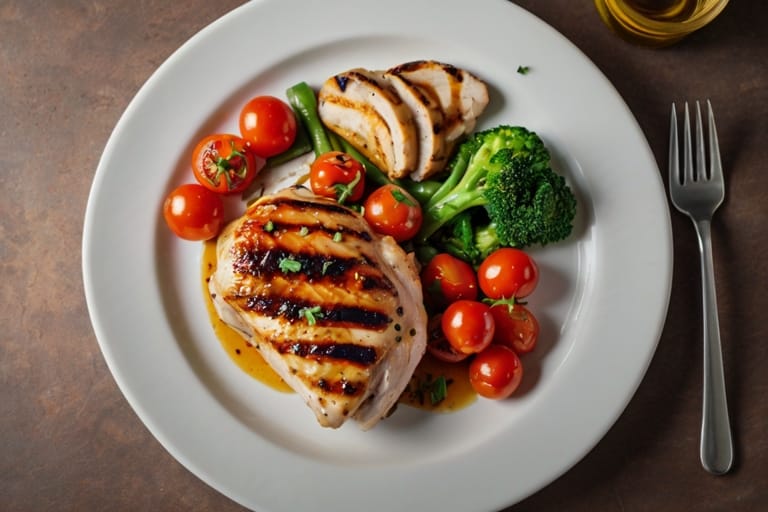Table of contents
Introduction
Chicken is a staple in many diets around the world, and for good reason. It’s a versatile, lean protein that’s not only delicious but also packed with essential nutrients. However, the way you cook and consume chicken can significantly impact its health benefits. In this article, we’ll explore the healthiest ways to eat chicken, covering everything from the nutritional benefits and cooking methods to common problems and solutions. Whether you’re a seasoned cook or just looking to improve your diet, this guide will provide you with all the information you need to make the most of this nutritious meat.
Nutritional Benefits of Chicken
Chicken is renowned for its nutritional profile, making it an excellent choice for those seeking a healthy and balanced diet. Let’s dive into the key nutrients that chicken provides.
Protein Content
One of the primary reasons people choose chicken is its high protein content. Protein is essential for muscle growth, repair, and overall body function. A 3-ounce serving of skinless, boneless chicken breast provides approximately 26 grams of protein, making it an excellent source of this vital nutrient.
Vitamins and Minerals
In addition to protein, chicken is rich in essential vitamins and minerals. Some of the key nutrients found in chicken include:
- Vitamin B6: Supports brain health and energy metabolism.
- Vitamin B12: Essential for red blood cell formation and neurological function.
- Niacin (Vitamin B3): Helps convert food into energy and supports skin health.
- Phosphorus: Important for strong bones and teeth.
- Selenium: A powerful antioxidant that supports immune function.
A detailed diagram illustrating the protein, vitamins, and minerals found in chicken breast.
Common Methods of Cooking Chicken
There are various ways to cook chicken, but not all methods are created equal when it comes to health. Let’s examine some common cooking methods and their impact on the nutritional value of chicken.
Grilling
Grilling is a popular method for cooking chicken, especially during the summer months. It imparts a delicious smoky flavor and requires little added fat. However, it’s important to avoid charring the meat, as this can create harmful compounds.
Baking
Baking is a straightforward and healthy way to cook chicken. It allows you to control the ingredients and avoid excess fat. Using parchment paper or a baking dish with a lid can help retain moisture and prevent the chicken from drying out.
Boiling
Boiling chicken is one of the healthiest methods as it doesn’t require added fat. It’s ideal for making soups and salads. However, it can sometimes result in a bland taste, so seasoning the water or using broth can enhance the flavor.
Frying
Frying chicken, particularly deep frying, is one of the least healthy methods due to the high fat and calorie content. While it may be tasty, it’s best to enjoy fried chicken occasionally and opt for healthier cooking methods for regular consumption.
Healthiest Cooking Methods
Now that we’ve covered common cooking methods, let’s focus on the healthiest ways to cook chicken and their benefits.
Grilling: Pros and Cons
Pros:
- Adds a delicious smoky flavor.
- Requires little to no added fat.
- Cooks chicken quickly, locking in nutrients.
Cons:
- Risk of charring, which can create harmful compounds.
- Can dry out the chicken if not monitored closely.
Baking: Pros and Cons
Pros:
- Allows for control over ingredients and seasoning.
- Retains moisture, especially when using a lid or parchment paper.
- Requires little added fat.
Cons:
- Can take longer to cook compared to other methods.
- May not provide the same depth of flavor as grilling.
Boiling: Pros and Cons
Pros:
- Requires no added fat.
- Ideal for making soups and salads.
- Helps retain moisture and tenderness.
Cons:
- Can result in a bland taste if not properly seasoned.
- May cause loss of some water-soluble vitamins if not using the cooking liquid.
A chart comparing the pros and cons of grilling, baking, boiling, and frying chicken.
Healthiest Chicken Recipes
Incorporating healthy chicken recipes into your diet can make eating nutritious meals enjoyable and satisfying. Here are some delicious and healthy chicken recipes to try.
Grilled Chicken Salad
A grilled chicken salad is a refreshing and nutrient-dense meal. Combine grilled chicken with a variety of fresh vegetables, leafy greens, and a light vinaigrette. Add some nuts or seeds for extra crunch and nutrition.
Baked Chicken with Vegetables
Baked chicken with vegetables is a simple yet flavorful dish. Season chicken breasts with herbs and spices, then bake them alongside a mix of colorful vegetables like bell peppers, carrots, and zucchini. This one-pan meal is convenient and packed with nutrients.
Chicken Soup
A hearty chicken soup is perfect for a comforting and nourishing meal. Boil chicken with vegetables, herbs, and spices to create a flavorful broth. Add some whole grains like quinoa or barley for extra fiber and nutrients.
A hearty bowl of chicken soup filled with nutritious vegetables.
Common Problems and Solutions
Even with the healthiest cooking methods, you might encounter some common issues when preparing chicken. Here are solutions to help you overcome these problems.
Dry Chicken
Dry chicken is a common complaint, but it can be easily avoided with the right techniques:
- Don’t Overcook: Use a meat thermometer to ensure the chicken reaches an internal temperature of 165°F (75°C) without overcooking.
- Marinate: Marinating chicken in a mixture of olive oil, lemon juice, and herbs can help keep it moist.
- Use Moist Cooking Methods: Opt for methods like poaching or slow cooking that help retain moisture.
Flavorless Chicken
Sometimes, chicken can turn out bland if not properly seasoned. Here’s how to boost its flavor:
- Season Generously: Use a mix of herbs, spices, and citrus to add depth to the taste. Garlic, paprika, thyme, and rosemary are great choices.
- Marinate Before Cooking: Letting the chicken sit in a flavorful marinade for at least 30 minutes can make a big difference.
- Use Broth: Cooking chicken in broth instead of water can add extra flavor.
Overcooked Chicken
Overcooking can make chicken tough and unappetizing. Here are tips to avoid this:
- Monitor Cooking Time: Keep a close eye on the cooking time and check the temperature with a meat thermometer.
- Lower Heat: Cooking at a lower temperature for a longer time can help maintain tenderness.
- Resting Period: Allow the chicken to rest for a few minutes after cooking to lock in juices.
Tips for Healthier Chicken Meals
In addition to cooking methods, there are other ways to ensure your chicken meals are as healthy as possible.
Choosing the Right Cut
Different cuts of chicken have varying nutritional profiles. For the healthiest options:
- Opt for Skinless Breasts: Skinless chicken breasts are lean and low in fat, making them an excellent choice for healthy meals.
- Consider Thighs: While slightly higher in fat, chicken thighs can still be a healthy option if cooked without the skin.
- Avoid Processed Chicken: Steer clear of processed chicken products like nuggets and patties, which often contain added fats and preservatives.
Marinating for Flavor
Marinating not only adds flavor but can also tenderize the meat and make it juicier:
- Healthy Marinades: Use olive oil, vinegar, lemon juice, and herbs for a nutritious marinade.
- Avoid Sugary Sauces: Steer clear of marinades high in sugar and artificial ingredients.
- Marinate in Advance: Marinating the chicken for several hours or overnight can enhance the flavor significantly.
Portion Control
Maintaining proper portion sizes is key to a balanced diet:
- Standard Portion Size: A typical serving size for chicken is about 3-4 ounces (roughly the size of a deck of cards).
- Balance Your Plate: Pair chicken with plenty of vegetables and whole grains to create a balanced meal.
- Use Smaller Plates: Eating from smaller plates can help control portion sizes and prevent overeating.
A chart comparing the pros and cons of grilling, baking, boiling, and frying chicken.
Healthiest Chicken Recipes (Continued)
Let’s explore more healthy chicken recipes to diversify your meals.
Chicken and Quinoa Bowl
A chicken and quinoa bowl is a nutrient-packed meal that’s easy to customize. Combine cooked quinoa with shredded chicken, black beans, corn, avocado, and a sprinkle of cheese. Top with a dollop of Greek yogurt and a squeeze of lime.

Chicken and Vegetable Stir-Fry
A stir-fry is a quick and healthy meal option. Sauté sliced chicken breast with a mix of colorful vegetables like bell peppers, broccoli, and snap peas. Add a low-sodium soy sauce or teriyaki sauce for flavor. Serve over brown rice or noodles.
Chicken and Spinach Wrap
Wraps are a convenient and portable meal option. Fill a whole-grain wrap with sliced chicken breast, fresh spinach, sliced tomatoes, and a light hummus or tzatziki sauce. Roll it up and enjoy!
A hearty bowl of chicken soup filled with nutritious vegetables.
FAQs About Healthy Chicken Eating
Here are some frequently asked questions about healthy ways to eat chicken:
What is the Best Cut of Chicken for Health?
Skinless chicken breasts are the healthiest cut due to their low fat and high protein content. However, skinless thighs can also be a nutritious option.
How Can I Make Chicken More Flavorful Without Adding Extra Calories?
Use herbs, spices, citrus, and low-calorie marinades to add flavor. Cooking chicken in broth instead of water can also enhance its taste.
Is Grilled Chicken Healthier Than Fried Chicken?
Yes, grilled chicken is healthier than fried chicken because it contains less fat and calories. Grilling also helps retain more nutrients.
Can I Include Chicken in a Weight Loss Diet?
Absolutely! Chicken is a great source of lean protein that can help keep you full and satisfied, making it a valuable addition to a weight loss diet.
How Should I Store Cooked Chicken?
Store cooked chicken in an airtight container in the refrigerator for up to 3-4 days. For longer storage, freeze it in portioned containers for up to 3 months.
Conclusion
Chicken is a nutritious and versatile protein that can be part of a healthy diet when prepared correctly. By choosing healthier cooking methods like grilling, baking, and boiling, you can maximize its nutritional benefits. Additionally, using proper seasoning, marinating, and portion control can enhance the flavor and healthfulness of your chicken meals. Whether you’re enjoying a grilled chicken salad, a hearty chicken soup, or a flavorful stir-fry, there are countless ways to incorporate this lean protein into your diet. Remember to experiment with different recipes and cooking techniques to keep your meals exciting and enjoyable.

